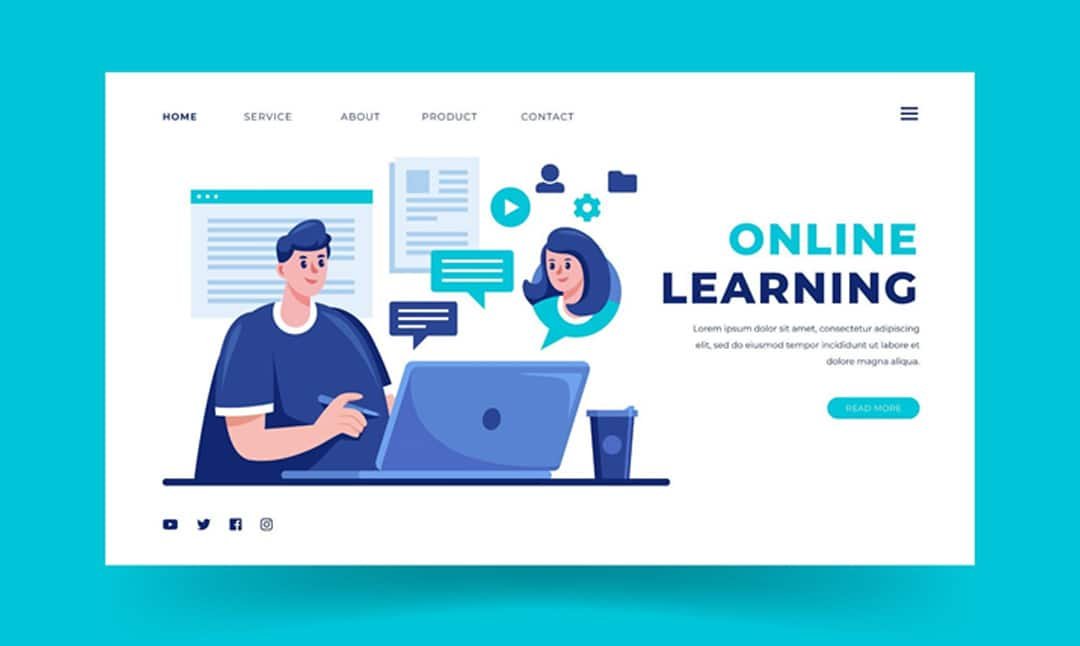Tech
Online Courses Website Design and Development Checklist
Published
1 year agoon
By
Admin
Online education is booming in the Middle East – and for all the right reasons.
These courses act as mini degrees and equip professionals with the right skillset when and where they need them. These courses are flexible, affordable and now greatly supported by employers and governments.
Building onto the convenience students and professionals experience when learning online, a website that gives access to a variety of such exclusive content for affordable prices is definitely a monetizable idea.
If you too are sold on building and launching an online courses website exclusively for the population of the Middle East, here is a quick process you should check before hiring web developers in Dubai to develop the portal.
Here are the Steps for Design a Courses Website
Step 1: Planning
1. Website Goals
Establish objectives such as providing educational content, attracting students, and generating revenue from course enrollments.
2. Target Audience
Understand the demographics, learning preferences, and needs of potential students to tailor the website accordingly.
3. Market Research
Analyze the online education market, including trends, popular topics, and user behaviors, to inform design and content strategy.
4. Analyze Competitors
Study successful online course platforms like Udemy to identify best practices, features, and areas for differentiation.
5. Create a Course Structure
Develop a clear and organized structure for listing and categorizing courses.
6. Establish Budget
Determine the budget for design, development, content creation, marketing, and ongoing maintenance.
7. Set Timeline
Create a realistic timeline for each phase of the project to ensure timely delivery.
8. Develop a Project Plan
Outline tasks, milestones, and responsibilities, ensuring all team members are aligned and aware of their roles.
Step 2: Prototyping
- Sketch Layouts
Draw initial layouts for key pages such as the homepage, course listings, and individual course pages.
- Define Structure
Create a clear and intuitive navigation system that allows users to easily find and access courses.
- Create Wireframes
Develop wireframes focusing on layout and functionality without detailed design elements.
- Plan User Flow
Map out the user journey from landing on the site to enrolling in a course.
- Get Stakeholder Feedback
Collect feedback from instructors, potential students, and stakeholders to refine the wireframes.
- Create High-Fidelity Mockups
Design detailed mockups with visual elements, including colors, fonts, and images, reflecting the brand identity.
- Choose Color and Typography
Select colors and fonts that convey professionalism and appeal to the target audience.
- Conduct Usability Testing and Revise Mockups
Test the mockups with users to identify usability issues and make necessary revisions.
Step 3: Monetization Strategy
1. Research Monetization Options
Explore different revenue models, such as pay-per-course, subscription plans, and certifications.
2. Analyze Competitor Monetization Models
Understand how competitors monetize their online course platforms to identify effective strategies.
3. Define Pricing Strategy
Develop a pricing model for courses, subscriptions, or memberships that balances affordability and profitability.
4. Plan Course Bundling
Offer bundled courses at a discounted rate to increase enrollment and value for users.
5. Implement Certification Fees
Charge for certifications or badges upon course completion to generate additional revenue.
6. Consider Affiliate Marketing
Partner with other educational platforms, tools, or resources for affiliate marketing opportunities.
7. Estimate Revenue Projections
Project potential revenue based on chosen monetization strategies and market analysis.
8. Get Stakeholder Approval
Ensure all stakeholders agree on the monetization strategy to align with business goals and user expectations.
Step 4: Development
- Development Environment
Configure the development environment with necessary tools and frameworks for building the website.
- Develop Frontend Code
Create the user interface using HTML, CSS, and JavaScript, ensuring responsiveness and cross-browser compatibility.
- Implement Course Management System
Develop or integrate a system to manage course creation, enrollment, progress tracking, and certifications.
- Develop Backend Code
Build server-side functionality to manage user accounts, course data, and transactions.
- Integrate Payment Gateway
Implement a secure payment gateway to handle transactions for course enrollments and subscriptions.
- Implement Security Measures
Secure the website with SSL certificates, data encryption, and other security protocols to protect user data.
- Set Up Database
Design and configure a database to store course content, user information, and transaction data.
- Optimize Performance
Ensure fast loading times and smooth performance by optimizing images, code, and server configurations.
Step 5: Testing and Launch
1. Perform Functional Testing
Test all features and functionalities to ensure they work as intended, including course enrollment, video playback, and quizzes.
2. Conduct User Acceptance Testing
Involve instructors and potential students in testing to validate the website meets their needs and expectations.
3. Test on Multiple Devices
Because a lot of students prefer accessing these courses from mobile, you need to ensure the website is fully functional and visually appealing on various devices, including desktops, tablets, and smartphones. To achieve this, partnering with an professional app development company in Dubai can provide the expertise needed to create a seamless and engaging user experience across all platforms.
4. Conduct Security Testing
Identify and fix vulnerabilities to protect the website and user data from potential threats.
5. Perform Performance Testing
Evaluate the website’s speed, responsiveness, and scalability under different conditions.
6. Fix Bugs and Issues
Address any bugs or issues identified during testing to ensure a smooth user experience.
7. Prepare for Launch
Finalize all preparations, including content updates, SEO optimizations, and marketing materials.
8. Launch the Website
Go live with the website, making it accessible to the public and starting to monitor its performance and user engagement.
Step 6: Marketing
1. Develop Marketing Plan
Create a comprehensive marketing strategy to promote the website and attract students and instructors.
2. Create Promotional Content
Develop engaging content, such as blog posts, videos, and infographics, to attract and retain users.
3. Optimize for SEO
Implement SEO best practices to improve the website’s visibility on search engines and attract organic traffic.
4. Plan Social Media Campaigns
Use social media platforms to reach a wider audience, share course highlights, and engage with users.
5. Engage with Influencers and Educational Bloggers
Partner with influencers and bloggers to promote the website and increase its credibility.
6. Launch Email Marketing Campaigns
Use email marketing to nurture leads, share new courses, and provide valuable content to subscribers.
7. Monitor User Feedback and Reviews
Regularly check user feedback and reviews to identify areas for improvement and address any issues promptly.
8. Analyze Marketing Metrics and Adjust Strategy
Continuously monitor marketing performance and adjust strategies based on data and insights to achieve better results.


Top 10 Magic Shirts You Need in Your Wardrobe – PurpleHecate

Best Ugly Christmas Sweaters for Nerds 2025 | GeeksOutfit

How Digital Title Search Platforms Are Making Property Due Diligence Faster and Smarter

Five Things to do in Lima, Peru

Best IPTV Service: Why Guru IPTV Stands Out

How to Plan a 48-Hour Luxury Trip to London

Benefits of Partnering with an Expert Foundry

Choosing the Right Supported Independent Living Option for Your Needs

Why Companies Worldwide Are Hiring Power BI Developers

Experience Pure Android Gameplay with MuMuPlayer Emulator

Carol Kirkwood’s Journey: Her Real Age, Husband, Career, and More

Revolutionizing Healthcare: The Emergence of AI-Driven Analytics

How Machine Learning and AI are Redefining the Future?

Aliza Barber: Meet Lance Barber’s Wife, Age, Life, Profile, Career and Net Worth

Evelyn Melendez: Jordan Knight’s Wife Bio, Marriage, Family, Career and Net Worth

Ilan Tobianah Biography: Family, Marriage, Lifestyle, Career and Net Worth

Who was Alice Marrow? Everything to Know About Ice-T’s and His Mother

King Von’s Autopsy Report: The Truth Behind the Tragic Death

Meet Otelia Cox: The Supportive Wife of Tony Cox – A True Fairy Tale Romance

Tea Leoni and Tim Daly Split – A Closer Look at Their Relationship and Breakup

Top 10 Magic Shirts You Need in Your Wardrobe – PurpleHecate

Best Ugly Christmas Sweaters for Nerds 2025 | GeeksOutfit

How Digital Title Search Platforms Are Making Property Due Diligence Faster and Smarter

Five Things to do in Lima, Peru

Best IPTV Service: Why Guru IPTV Stands Out

How to Plan a 48-Hour Luxury Trip to London

Benefits of Partnering with an Expert Foundry

Choosing the Right Supported Independent Living Option for Your Needs

Why Companies Worldwide Are Hiring Power BI Developers

Experience Pure Android Gameplay with MuMuPlayer Emulator
Category
Trending
-

 News3 months ago
News3 months agoCarol Kirkwood’s Journey: Her Real Age, Husband, Career, and More
-

 Health2 years ago
Health2 years agoRevolutionizing Healthcare: The Emergence of AI-Driven Analytics
-

 Technology2 years ago
Technology2 years agoHow Machine Learning and AI are Redefining the Future?
-

 Celebrity2 years ago
Celebrity2 years agoAliza Barber: Meet Lance Barber’s Wife, Age, Life, Profile, Career and Net Worth




